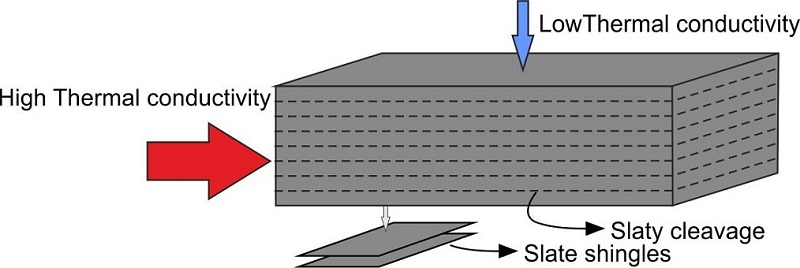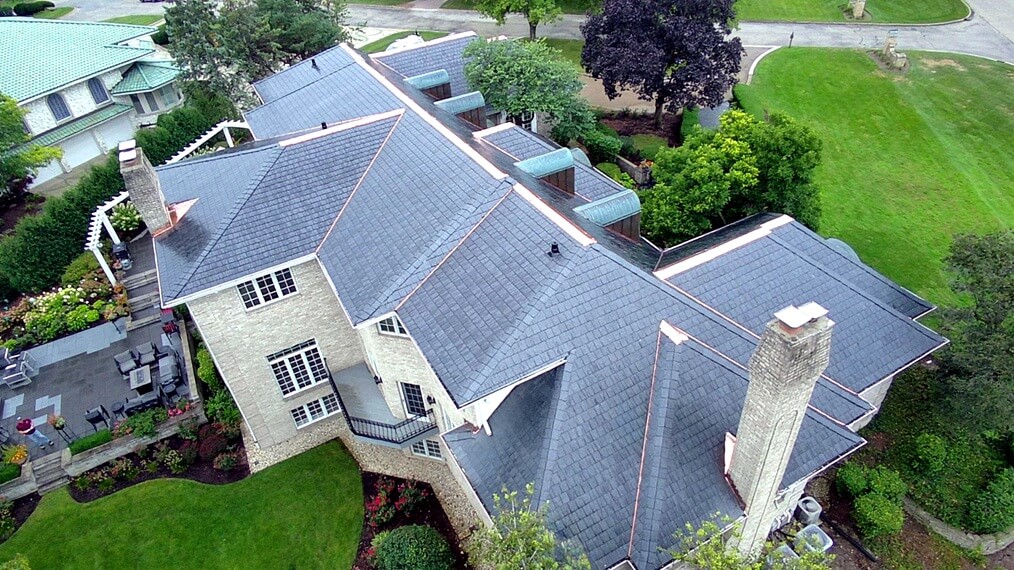Thermal behavior of roofing slates
Why do we use slate to cover roofs? There are many good answers to these questions: slate is waterproof, can be split into thin, regular and flat shingles. Slate is durable and has been used for centuries in many exceptional buildings, and (my favourite) slate is a beautiful natural rock with outstanding aesthetics. However, have you thought about thermal properties? There’s no doubt that roofing slates are good insulators under many different climatic conditions. I have seen slate roofs in the temperature range from about -30 °C (or -22 °F) in Norway to 40 °C (or 104 °F) in Spain, working without problem.
Today we are going to take a look to the thermal conductivity and thermal inertia of roofing slates. Thermal conductivity is the capacity of any material to transmit heat, and it is roughly expressed as the amount of heat transferred by a given distance of a material, and it is measured in watts divided by distance and temperature [W/(m·K)]. The lower the value, the more insulating the material. Natural rocks used in construction show values such as 1.72-3.85 for granite, 2.08-2.94 for marble, 2.00 for sandstone, and 1.49 for slate. As you can see, slate has the lowest thermal conductivity value.
This means that temperature dispersion is less efficient in slate, in other words, it is more efficient at insulating. However, this is only for natural rocks. Artificial construction materials, such as concrete (0.10 – 1.70) may have lower values, not to mention insulators, which usually have values below 0.1. In any case, these materials are not comparable to natural rocks, since they are used as a complement or reinforcement of the building, and never in the external part.
In 2019, a group of researchers from the Czech Republic published a scientific paper measuring thermal properties in roofing slates from Moravia and Carpathia. In these regions of the Czech Republic roofing slates have been exploited for centuries. In 1880, more than 50 quarries were working in Moravia, but nowadays only one mine is still active. These researchers found a thermal conductivity of 1.43-1.79 for Moravian slates, and 1.99-3.15 for Carpathian slates. These are higher values than others values reported for more common roofing slates. But perhaps the most interesting conclusion is the influence of the slaty cleavage on the thermal conductivity.
As you all know, slaty cleavage is the characteristic structure of slate that allows it to be split into shingles. This slaty cleavage also creates a very high structural anisotropy: properties are not the same in the perpendicular section to the slaty cleavage than parallel to it. In this case, thermal conductivity is over 2 times higher in the section parallel to the slaty cleavage than in the section perpendicular to the slaty cleavage. This means that the surface of a slate shingle is always the section with the lowest thermal conductivity.
On the other hand, thermal inertia is defined by the Merriam-Webster as “the degree of slowness with which the temperature of a body approaches that of its surroundings”. In other words, how long will the slate remain warm during the night, after being exposed to sunlight all day. Thermal inertia acts like a temperature cushion.
This can be clearly seen in the following graph, which represents temperature of a slate (in grey) compared with the temperature of the air (in blue) during one day in the Winter (right) and in the Summer (left). This data belongs to a very long series that I’ve been registering since 2007, where I installed an experimental slate roof that measures temperatures of the air and the slate every hour.
The roof is in Sobradelo, close to the main Spanish quarries. In the summer, the slate is always some degrees below the air temperature until the sunlight reaches it. Then the temperature is greatly increased. Remember, you don’t have to lose all this energy, you can harness it for heating domestic water by using the natural roofing slate panels Thermoslate. On the other hand, during winter, the effect of the sunlight is not that strong, and the slate keeps its temperature few degrees below the air’s temperature.
Thus, Roofing slate has good thermal behavior, but this doesn’t mean that you don’t need anything else to have a well insulated roof. Slate is the external part of the roof, the outer shield that protects your house against weather, but sometimes you will still need a properly designed insulating chamber. Only a skilled professional installer can give reliable advice, do not forget that.
Further reading:
Labus, M., Labus, K., & Bujok, P. (2019). Thermal parameters of roofing slates from Czech Republic. Journal of Thermal Analysis and Calorimetry, 9. doi:10.1007/s10973-019-08969-0







